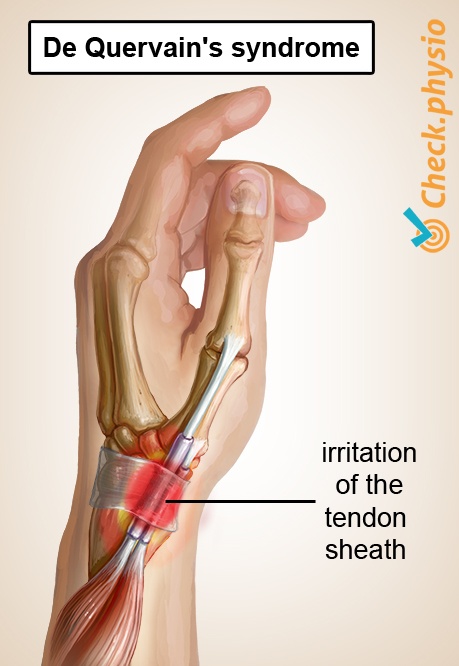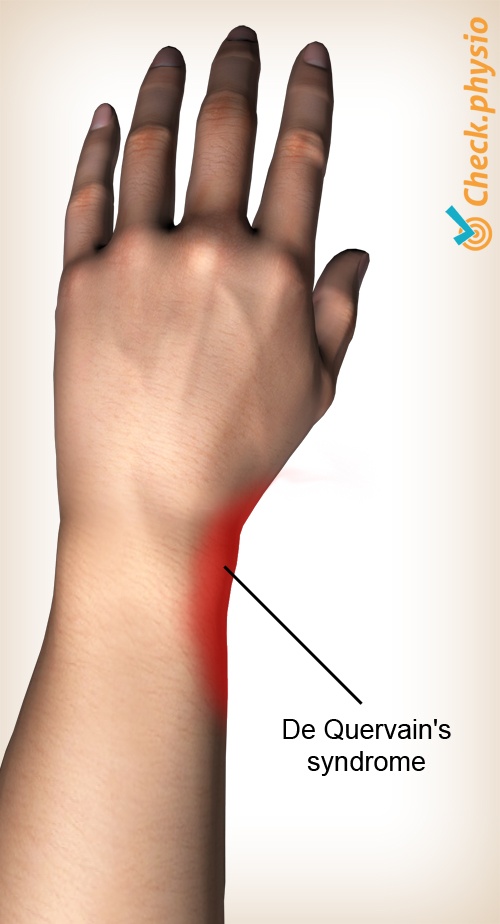- Conditions
- De Quervain's disease
De Quervain's disease De Quervain's disease / gamer's thumb / mother's wrist
Introduction
De Quervain's disease is associated with pain and swelling on the thumb-side of the wrist. The underlying cause is irritation of the tendon sheath and the two tendons that run through this sheath.
The symptoms are very similar to those of oarsman's wrist.

Description of condition
The thumb and the wrist are moved by muscles located in the forearm. The tendons of these muscles attach to the various bone sections around the wrist, thumb and fingers. The tendons that go to the thumb glide through a smooth sheath in the wrist joint to ensure that the tendons experience as little friction as possible. Such a sheath is called a "tendon sheath".
In De Quervain's syndrome, there is irritation of the tendon sheath and the tendons that run through it. The affected tendons are those attached to the "extensor pollicis brevis" and "abductor pollicis longus" muscles. The irritated tendon sheath is located on the thumb-side of the forearm and causes pain symptoms there when the hand or thumb is used.
Cause and history
The symptoms usually occur as a result of overuse. Examples include working in the garden or long periods of knitting. It is more common in those who play volleyball and racket sports rather than in other sports. Young mothers who care for a baby are also more likely to develop the condition from repeatedly holding a baby tightly and carefully.
Signs & symptoms
- Pain when flexing and extending the thumb, particularly during grasping or wringing motions.
- The pain is located on the thumb-side of the forearm.
- Swelling at the location of the tendon sheath.
- The tendons of the thumb may "snag". This may be accompanied by a snapping sound or sensation.
- Numbness may occur over the extensor side of the thumb and forefinger if the nerve in the affected area also becomes irritated.
Diagnosis
The diagnosis is made after an interview and physical examination. The healthcare professional asks about the cause and severity of the complaints and performs various tests.
In some cases, additional testing is needed. An ultrasound is used to see if the tendons are moving properly within the tendon sheath.
Treatment and recovery
In many cases, rest and prevention of further overuse is sufficient. A splint can be used to rest the joint for a short period. Anti-inflammatories or corticosteroid injections may sometimes be administered if the symptoms do not disappear. In extreme cases, minor surgery can be considered, in which the tendon sheath is slit open to allow the affected tendons more space.
More info
You can check your symptoms using the online physiotherapy check or make an appointment with a physiotherapy practice in your locality.
References
Verhaar, J.A.N. & Linden, A.J. van der (2005) Orthopedie Houten: Bohn Stafleu van Loghum.
Parmelee-Peters, K., Eathorne, S.W. (2005) The wrist: common injuries and management Prim Care. 2005 Mar;32(1):35-70.
Peters-Veluthamaningal, C., Willems, W., Smeets, J.G.E., Windt, D.A.W.M. Van der, Spies, M.N., Strackee, S.D., Vos, K., Wind, L.A. & Geraets, J.J.X.R. (2010) NHG-Standaard. Hand- en polsklachten Huisarts Wet. 2010:53(1):22-39.

